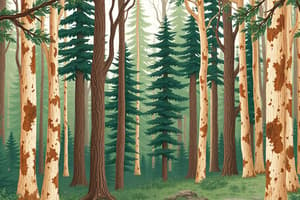Podcast
Questions and Answers
Which type of ecosystem includes habitats like oceans and estuaries?
Which type of ecosystem includes habitats like oceans and estuaries?
- Terrestrial ecosystems
- Aquatic ecosystems (correct)
- Desert ecosystems
- Savannah ecosystems
What type of organisms are primary producers in aquatic ecosystems?
What type of organisms are primary producers in aquatic ecosystems?
- Cacti
- Camels
- Succulents
- Phytoplankton (correct)
Which adaptation helps desert species conserve water in arid environments?
Which adaptation helps desert species conserve water in arid environments?
- Succulents (correct)
- Fish
- Grasslands
- Phytoplankton
What defines terrestrial ecosystems?
What defines terrestrial ecosystems?
Which ecosystem type is characterized by extreme temperatures and water scarcity?
Which ecosystem type is characterized by extreme temperatures and water scarcity?
Which of the following is a component of ecosystems?
Which of the following is a component of ecosystems?
What is the primary function of decomposers in ecosystems?
What is the primary function of decomposers in ecosystems?
In forest ecosystems, what are primary producers?
In forest ecosystems, what are primary producers?
Which ecosystem is characterized by low tree cover and a dominance of grasses and herbs?
Which ecosystem is characterized by low tree cover and a dominance of grasses and herbs?
Why are grasslands able to maintain their productivity?
Why are grasslands able to maintain their productivity?
Flashcards are hidden until you start studying
Study Notes
Ecosystems - Components and Types
Ecosystems form the foundation of ecological studies and are essential for understanding how organisms interact with each other and their environment. They consist of living entities, such as plants, animals, and microorganisms, and non-living elements like water, air, soil, sunlight, and climate. These components work together in a dynamic balance that sustains life and maintains the health of the ecosystem over time. An ecosystem is more than just individual species; it's a complex network of interactions between different biological levels, including populations, communities, and biomes.
The study of ecosystems has revealed various types based on factors like habitat size, biological interactions, and climate conditions. Some common ecosystem types include:
Forest Ecosystems
These systems are characterized by tall trees and a large population of plants. Animals vary widely based on available food resources. Primary producers include photosynthetic organisms like mosses and lichens, while decomposers help break down dead organic material.
Grassland Ecosystems
Grasslands are dominated by grasses and herbs, with low tree cover and a variety of animals adapted to grazing. Recycling nutrients back into the soil helps maintain productivity. Decomposer organisms play an essential role in breaking down dead plant and animal materials.
Desert Ecosystems
Deserts consist mostly of sand, rocks, and sparse vegetation adapted to extreme temperatures and water scarcity. Many species have unique adaptations to conserve water, such as succulents and camels.
Aquatic Ecosystems
These systems cover freshwater, saltwater, and brackish water habitats. Organisms are adapted to underwater environments, with primary producers like phytoplankton and larger organisms like fish and aquatic plants.
Ecosystems can be further divided into subcategories like marine ecosystems (oceans, estuaries), freshwater ecosystems (rivers, lakes), and terrestrial ecosystems (forests, grasslands, wetlands). Each type has unique characteristics and challenges, but all are interconnected, serving as part of an intricate web of life that sustains our planet.
Studying That Suits You
Use AI to generate personalized quizzes and flashcards to suit your learning preferences.




